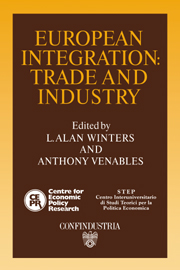Book contents
- Frontmatter
- Contents
- List of figures
- List of tables
- Preface
- Acknowledgements
- List of conference participants
- 1 European integration: trade and industry
- 2 Completing the internal market in the EC: factor demands and comparative advantage
- Discussion
- 3 External effects and Europe's integration
- Discussion
- 4 The quality and production of textiles and clothing and the completion of the internal market
- Discussion
- 5 Competition and imports in the European market
- Discussion
- 6 The structure and determinants of East–West trade: a preliminary analysis of the manufacturing sector
- Discussion
- 7 1992 and EFTA
- Discussion
- 8 Technology policy in the completed European market
- Discussion
- 9 Corporation tax, foreign direct investment and the single market
- Discussion
- 10 Japanese direct manufacturing investment in Europe
- Discussion
- Index
4 - The quality and production of textiles and clothing and the completion of the internal market
Published online by Cambridge University Press: 07 September 2010
- Frontmatter
- Contents
- List of figures
- List of tables
- Preface
- Acknowledgements
- List of conference participants
- 1 European integration: trade and industry
- 2 Completing the internal market in the EC: factor demands and comparative advantage
- Discussion
- 3 External effects and Europe's integration
- Discussion
- 4 The quality and production of textiles and clothing and the completion of the internal market
- Discussion
- 5 Competition and imports in the European market
- Discussion
- 6 The structure and determinants of East–West trade: a preliminary analysis of the manufacturing sector
- Discussion
- 7 1992 and EFTA
- Discussion
- 8 Technology policy in the completed European market
- Discussion
- 9 Corporation tax, foreign direct investment and the single market
- Discussion
- 10 Japanese direct manufacturing investment in Europe
- Discussion
- Index
Summary
Introduction
Regulations in textile trade have a long history. The first multilateral agreement was signed in 1961; the most recent one will expire in 1991 and is most likely to be renewed. During these thirty years there have been major changes in the pattern of textile trade and production; the issue is whether these changes have gone far enough – or perhaps even in the right direction – for textile and clothing (T & C) trade to return to normal trade practices.
In this respect Italy represents an interesting case. As is well known, the Multi-Fibre agreement (MFA) (i.e., the main instrument of regulation in T & C) is of a discriminatory nature. In open violation of GATT principles, it is indeed applied mostly against exports from developing countries and does not interfere with trade flows among industrial countries. It is likely therefore to favour those countries, such as Italy, which within industrial countries hold a comparative advantage in T & C. As a matter of fact a country like Italy will not only benefit from protection in its domestic market, but also from the fact that other industrial countries restrict their market to developing countries.
It is not, therefore, altogether surprising to find that in Italy T & C continues to maintain a large share of industrial production, employment and exports.
- Type
- Chapter
- Information
- European IntegrationTrade and Industry, pp. 54 - 78Publisher: Cambridge University PressPrint publication year: 1991
- 6
- Cited by



